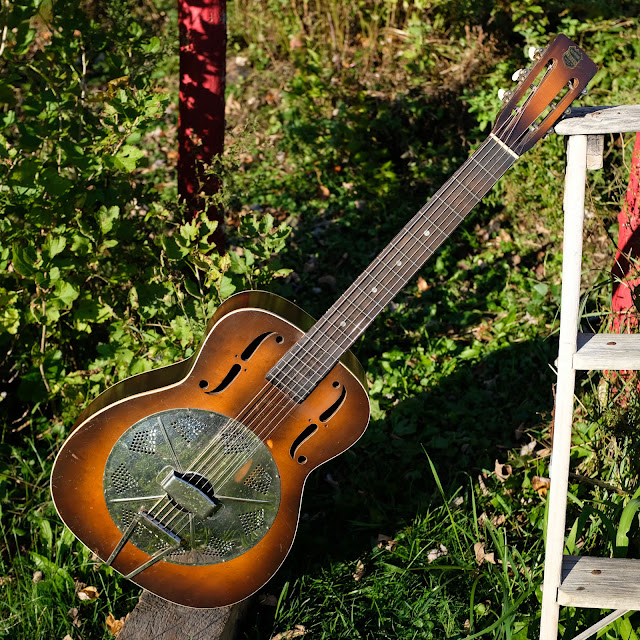1934 National Trojan Resonator Guitar
A customer of mine is an endless blues-box taste-tester (and wheel-n-dealer) and it's not surprising he would eventually wind his way back to another biscuit-cone resonator guitar. He's owned and had access to a good number of metal-bodied Nationals from the same era and even a few of the National-coned Kay jumbos from the '40s and '50s, but as all of those were pretty punishing on his ears in the highs for the small-room playing he's used to, he's hoping the mellower/woodier sound of this wood-bodied Trojan will do the trick.
I think it will -- but if it doesn't, it'll wind its way to the inventory page. That would make someone else happy, though, as this sucker certainly has a lot going on.
These Trojans have Harmony-made bodies and necks and they even employ the "usual" 25 1/8" Harmony scale length. Though there's a dowel that runs through the body and helps support the cone, the neck itself is actually dovetailed. The body itself is thick plywood birch, however, which is unlike Harmony's off-brand resonator instruments which tended to use a mix of solid and thinner ply and usually arrive with a number of cracks and structural funkiness.
The top and back are bound in white celluloid, the f-holes are extremely deco-cool, and the neck itself isn't too bulky or funky to enjoy getting-around on.
These guitars do have factory flaws, however -- the most obvious from a repairman's point of view being the ebonized-maple fretboards which deteriorate to an absurd extent over time. The board on this guitar had already been reglued and old hairline cracks in it glued-up before it arrived here. When it arrived here, too, there was no resonator under the hood. What? Yes. Sigh!
Work included a neck reset, fret level/dress, new National Reso-Phonic 9 1/2" cone install and custom bone, compensated saddle, general cleaning, new (old) screws for the coverplate and tailpiece, new (old) replacement tuners, and a good setup with 54w, 42w, 32w, 24w, 16, 12 strings. I think the neck would prefer a slightly-lighter gauge, but considering that this will probably be detuned a little and that the neck deflects only 1/64" overall at tension, I think it can handle these just fine. It plays with excellent 3/32" EA and 1/16" DGBE action at the 12th fret.
Repairing the fretboard extension over the body after the neck reset was a huge chore, by the way. The ebonized maple essentially exploded into more than a dozen shards the moment I had my seam separator under it. Whatever glue had been used to reglue it in the past also stuck to it like the devil and made removal more difficult. If you look closely at the pictures of the extension you'll see that I had to fill plenty of mucked-up "potholes" in the board. Copious amounts of superglue in various viscosities was used to massage it all back together and stable. It's not beautiful, but it's at least workmanly and kept the original looks.
The new cone also had to be massaged into place as the soundwell was too tight for it. I de-crimped the edges of the cone, refolded them a little differently, and fit it to the well in such a way that it also placed the biscuit and saddle in the proper position for correct intonation. I also used a "gasket" of a single layer of duct-tape in the bottom edge of the soundwell to reproduce the anti-rattle gasket approach National used on the metal-bodied guitars. It works, though it's more like extra insurance in this case.
Specs are: 25 1/8" scale length, 1 13/16" nut width, 1 21/32" string spacing at the nut, 2 1/16" spacing at the bridge, 14 1/8" lower bout, 10" upper bout, and 4 1/8" side depth at the endblock. The neck has a flat-profile board, smallish vintage frets, and a medium, C/V shape to its rear.
Materials are: ply birch body, maple neck, ebonized maple fretboard, maple biscuit, bone saddle, replacement brand-new National Reso-Phonic cone, replacement '50s parts-bin tuners.
The original bone nut has a hairline crack in it (and the fretboard has a few, too), but it's still going strong. As the crack doesn't line-up with the string slots, I left it.
The face of the board has pearl dots and I added side dots, too.
The coverplate definitely has some playwear but most of the hardware is pretty clean. Note that I'm not using the front-edge exit holes for the strings on the tailpiece. Instead I've strung it up with the strings running under the leading edge for extra back-angle on the saddle. There's a pad of leather below the whole tailpiece, too, to keep it from rattling on the coverplate.
There are plenty of light scratches, scuffing, and use-wear throughout.
There's a press-in on the back of the neck just before the heel. I know what that's from! When someone reglued the fretboard, that was where the clamp must've applied pressure to a block on the back of the neck. oops!
The replacement tuners are from a late-'50s Harmony guitar. The originals were, unfortunately, very trashed. Two of the shafts were shorn right off.
Here's a sneaky shot showing the compensated, bone saddle installed at the biscuit. Note the foam behind it -- that's for muting the string-afterlength running from the tailpiece to the saddle.



















Comments